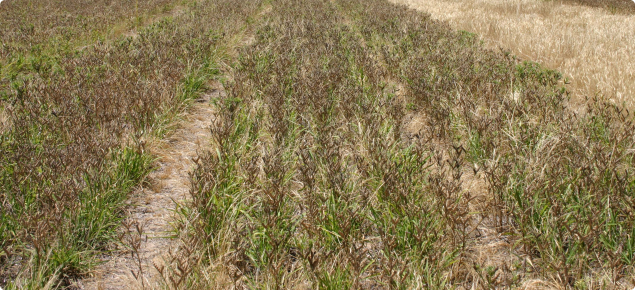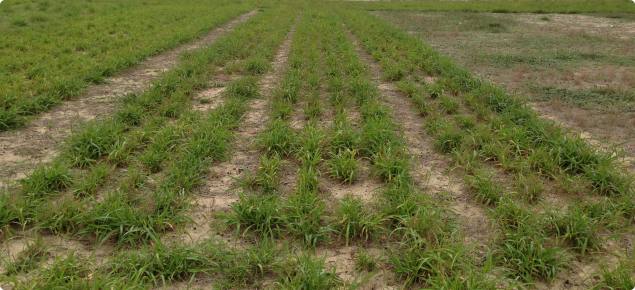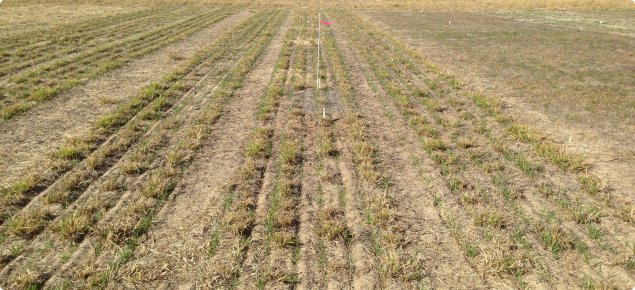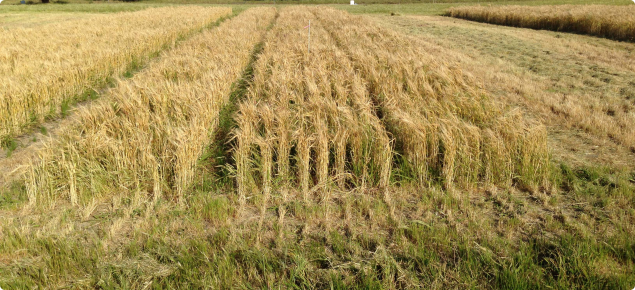Background and aim
From 2009-2013, personnel with the Future Farm Industries Cooperative Research Centre Ltd’s EverCrop project evaluated the viability of pasture cropping over different subtropical species at a focus site south-west of Moora.
The trial was based on a barley-lupin rotation with crops sown into annual and perennial pastures.
Results were very promising for both barley (2009, 2011) and lupin (2010, 2012) crops with little or no yield penalty (0-15%) in pasture crops when fertilised in line with district practice (Ward et al. 2012).
The perennial grasses at the focus site were originally sown in 2008; they established well, but over time the density of Rhodes grass has declined.
For instance, in 2012, Rhodes grass (unlike Gatton panic grass) did not recover well from the grass selective herbicide (Verdict®) sprayed on the lupin crop.
This report compares the grain yield results for the 2013 barley crop sown alone or into Gatton panic grass and Rhodes grass plots.
It also highlights biomass production over time for Gatton panic grass-based systems as a pasture crop could be used to supplement available feed of subtropical perennial grass pastures, especially in winter when they become dormant.
Trial details
| Property | Yanda (Chris Vanzetti’s) 20km south-west of Moora |
|---|---|
| Soil type | Deep pale sand: surface pH(CaCl2), 5.3 and OC, 1.1% (0-10cm) |
| Crop/variety | Buloke |
| Paddock rotation | 2009 - barley, 2010 - lupin, 2011 - barley, 2012 - lupin, 2013 - barley |
| Treatments |
Crop only with 50kg N/ha Crop only with 80kg N/ha Gatton panic only, 36cm row spacing Gatton panic, 36cm row spacing, pasture cropped with 50kg N/ha Gatton panic, 36cm row spacing, pasture cropped with 80kg N/ha Gatton panic only, 72cm row spacing Gatton panic, 72cm row spacing, pasture cropped with 50kg N/ha Gatton panic, 72cm row spacing, pasture cropped with 80kg N/ha Rhodes grass only, (originally 36cm row spacing) Rhodes grass, pasture cropped with 50kg N/ha Rhodes grass, pasture cropped with 80kg N/ha |
| Replicates | Three |
| Sowing date | 23 May 2013 |
| Seeding rate | 80kg/ha |
| Management inputs |
Fertiliser 23 May 2013 - seeding: 80kg/ha Agstar Extra 17 June 2013: 50kg/ha sulphate of ammonia, 50kg/ha muriate of potash, 30kg/ha urea 14 July 2013: 100kg/ha urea on high N plots, 30kg/ha urea on low N plots
Chemical Pre-seeding: 1.0L/ha Glyphosate 450 23 May 2013 - seeding: 1.0L/ha SpraySeed®, 3.0L/ha Treflan™ Post-seeding: 0.8 L/ha Barracuda®, 1.0L/ha Decision® |
Results
Biomass of Gatton panic grass and barley
Figure 1 shows standing green biomass of over time for Gatton panic grass and barley grown as pasture only, crop only or a combined (pasture-crop) system.
The perennial grass was mown twice in summer (30 January and 21 April 2013) to simulate grazing.
Perennial pasture growth is dependent on seasonal conditions, especially temperature and rainfall in spring and summer.
Between November 2012 and January 2013, 130mm of rain fell resulting in useful growth of the perennial grasses over summer (Figure 1).
Gatton panic grass produced between 860-1400kg/ha of feed in January.
But available green feed declined under dryer conditions and then with the onset of cooler temperatures in winter (June to July).
Barley sown alone produced 5.4t/ha of biomass but 26% less (4.3t/ha) when sown over subtropical grasses.
This difference was less (15%) when an extra 70kg/ha of urea was applied to the crop only and pasture-crop plots (7.5 vs 6.5t/ha biomass respectively).
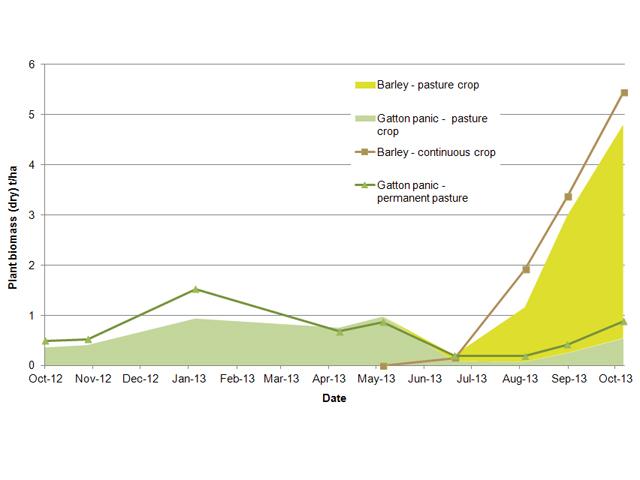
An additional 70kg/ha of urea was top dressed on high nitrogen plots each year.
In 2013, when soil moisture and temperature were favourable for perennial growth, 49% more biomass was produced in summer and 27% more in spring by subtropical grasses in the high nitrogen compared to the low nitrogen plots (Figure 2), however, a significant growth response to nitrogen has not been observed in previous years, thus fertiliser inputs may need to be carefully weighed up based on the presence of a pasture crop and how the season is progressing.
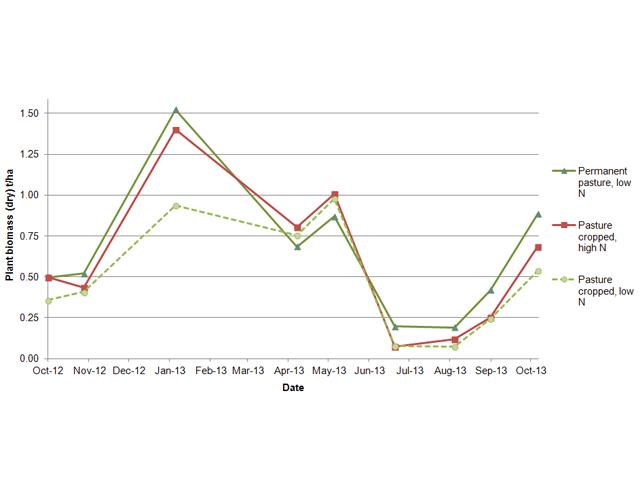
Grain yield of barley
The good season (121mm for November 2012 to April 2013 and 310mm for May to October) highlighted a nitrogen deficiency in both the barley crop and perennial grass pasture which is a common issue on high leaching deep sandy soils.
There was a significant yield boost (41%) in response to additional nitrogen (80 v 50 N) for the crop only treatments (that is, no perennial base) (Figure 3).
Barley sown in line with district practice (50kg N/ha; no perennial base) yielded 2.4t/ha.
Using this as a reference (or control) there was a yield penalty (nil to 18%) for crops sown across perennial grass treatments (Figure 3).
Additional nitrogen (extra 30kg N/ha) overcame this penalty.
However, if viewed from the perspective of equivalent nitrogen input the yield penalty was greater (19-26%) for pasture crops fertilised at the higher nitrogen rate (80kg N/ha) relative to the crop only, high nitrogen control (3.5t/ha).
When seeding annual crops into perennial grass pastures, there are logistical advantages to seed between wider rows.
The trial results showed that (a) there was no significant difference in grain yield for barley sown between narrow or wide row (36 vs 72cm) Gatton panic grass plots (Figure 3), and (b) there was little difference in panic biomass production between perennial row spacing treatments (data not shown).
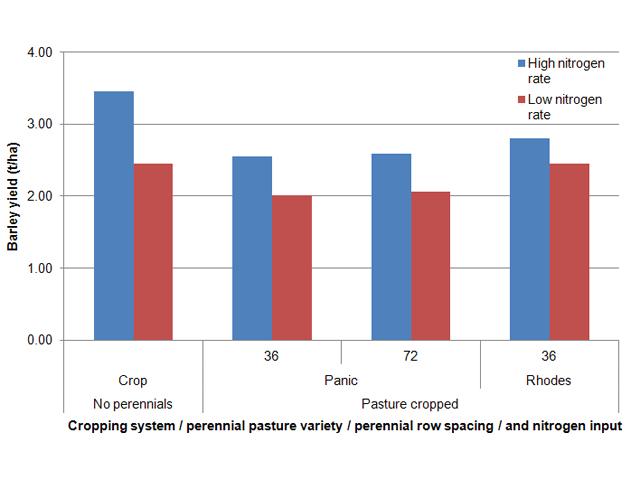
Conclusion
Results from the northern agricultural region have shown that crops can be sown over subtropical perennial grasses without jeopardising persistence of the perennial base.
However, perennial grasses vary in their tolerance to in-crop herbicides and crop yield is dependent on effective weed control, adequate fertility and moisture, and winter dormancy (or suppression) of the perennial pasture.
Pasture cropping systems can also lift overall biomass production, improve the feed value of stubbles, provide out of season fodder, and reduce the likelihood of wind erosion and groundwater recharge on deep sandy soils.
The application of additional nitrogen can lead to greater biomass in both the annual crop and perennial pasture, however, this is dependent on seasonal conditions and the economics of applying additional nitrogen needs to be considered carefully on low moisture holding, infertile, sandy soils in the northern agricultural region.
Acknowledgements
Thanks go to Chris Vanzetti and the department's research facility for managing the trial.
This research was funded by the Grains Research and Development Corporation through the Future Farm Industries Cooperative Research Centre Ltd’s EverCrop project (P2 FP09).

